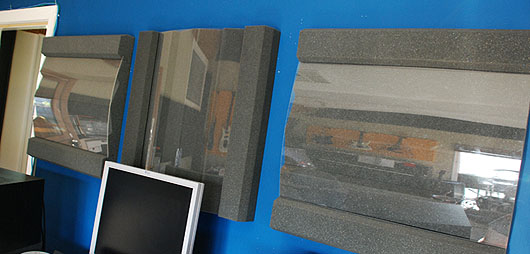Q: How much acoustic treatment is usually required?
A: How much acoustic treatment should be installed depends on a multitude of factors: size of room, construction of room, shape of room, purpose of room, floor coverings, furniture and it’s placement, personal taste (very important), music reproduction system (if applicable). For the project or professional studio owner, adequate acoustic control means the ability to create a balanced mix that will translate to other playback systems. It is easiest to achieve this in a room that has a flat frequency response, therefore any acoustic treatment should consist of both corner bass traps and wall mounted broad frequency panels. Most room accuracy issues exist below 300hz with peaks and troughs associated with “room modes”. Adequate bass reverberation control is the cornerstone of room acoustic treatment. The RK series room kits have been designed to provide a range of budget entry points for the typical small to medium sized room. These room kits provide balanced absorption across a broad frequency spectrum, and can be easily expanded as required.
READ MORE ABOUT ROOM ACOUSTICS
The RK room kits demonstrate progressive application of the three main aspects of acoustic treatment, bass trapping, first reflection points and general reverberation. The RKO5 is really only suitable for near field monitoring in situations where the side wall first reflection points are quite close to the speakers. For this application, the RKO5 will greatly improve the focus and imaging of the monitors, but will only will only reduce reverberation times by a small amount. At the other end of the spectrum is the RK3, which provides close to a complete acoustic treatment for critical listening applications. All four corners are bass trapped, first reflection points are well treated and the rear wall hybrid diffusion provides additional lower frequency control and high frequency diffusion. The only possible addition to this kit would be the treatment of all the ceiling corners.
Q: Will acoustic panels stop the noise escaping from the room? Is it soundproofing?
A: No, acoustic panels control reverb and reflections within the room, but do not prevent sound escaping from a room. In a normal house sound is transmitted through the physical structure of the house to the outside environment, as well as through the air. To soundproof a room to a very high level (such as totally stopping the sound of a drum kit) requires construction of a purpose built room that is “decoupled” from the surrounding environment. That is, a room not physically linked to the surrounding environment by utilising an airgap, and by sitting the structure on rubber blocks. A room within a room. In a normal house there are a multitude of ways of significantly reducing the sound escaping: double glazed windows, airtight solid core doors, double layers of plaster separated with rubber spacers (works quite well), just to name a few.
Q: Do bass traps reduce the bass I will hear? I like to hear plenty of bass!
A: The aim of bass traps is to reduce the natural resonance of a room. This can make some bass notes appear louder, and other frequencies disappear. The aim of bass traps is to even out bass frequencies (room modes) and improve bass definition.
Q: How should I treat a voiceover booth?
A: A voiceover booth should be an acoustically dead space. A voiceover booth for the purpose of ‘close mic’ voice recording can generally just be treated with a standard acoustic panel (AT600/40). A voiceover booth for the purpose recording singing, particularly a loud vocalist who may sing back from the mic, requires broadband treatment to absorb lower frequencies (SA600/75). Otherwise the recordings can sound ‘boxy’ due to uncontrolled 200 – 300hz frequencies. Some bass trapping can be helpful if the booth is to be used as an isolation booth for guitar amps. Coverage should be in the range of 70%, the more the better.
Q: What is a diffuser and do I need one?
A: Diffusers re-distribute the sound in a room without absorbing acoustic energy. The HA600/75 is a specially designed hybrid diffuser that selectively diffuses high frequencies and absorbs lower frequencies. This allows a room to retain a more natural sense of space while controlling lower frequencies.
Q: What is the best acoustic treatment for a room used to record drums?
A: For recording drums it is nice to try and capture a sense of space by keeping as much “liveness” in the room as possible, particularly for acoustic styles of music. When recording a drum kit it is the overhead and room mics which capture that sense of space. A good example of this is the drum sound on John Butler’s “Sunrise over Sea” album which has plenty of room mic in the mix. A room with uncontrolled low freq. resonance will impact on the quality of sound recorded by the mics some distance from the kit. Drum rooms tend to benefit from a reasonable degree of bass trapping to control resonance. The HA600/75 Hybrid Acoustic panel is an ideal panel for controlling the acoustics of a drum room, as the diffuser element selectively spreads high frequencies, while simultaneously absorbing the lower “boxy” frequencies. The diffuser can also be easily removed, allowing the panel to function purely as an absorber.

